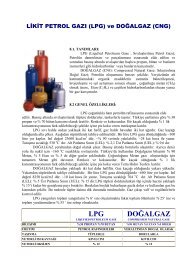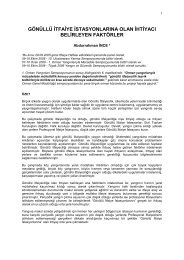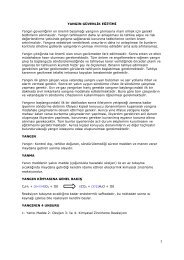buradan - Yangın
buradan - Yangın
buradan - Yangın
Create successful ePaper yourself
Turn your PDF publications into a flip-book with our unique Google optimized e-Paper software.
To keep sprinkler protection relevant and in tune with the needs<br />
of the warehouse operators we run many product development<br />
projects with end user operators. One such project was carried out<br />
as the end user wanted to use his warehouse in a way which was<br />
not allowed under standard sprinkler protection rules<br />
w No limits on the type of goods stored<br />
w 8.5m storage height with no in-rack sprinklers<br />
w Looser limits on the size and shape of pallets<br />
Such requirements cannot be met by standard or ESFR systems<br />
and so new sprinklers and system concepts have to be developed<br />
and tested Fire is not something which can adequately be modelled<br />
on a small scale and scaled up and for now the only way to test if a<br />
protection scheme will work is to run full scale fire tests.<br />
Worst Case Scenario<br />
8.5 m<br />
Figure 29. Worst case scenario<br />
Mattresses<br />
Candles<br />
To ensure an independent review of the project, the client requested<br />
the involvement of a an independent approvals body, in this case<br />
the VdS of Germany worked with the end user and ourselves to<br />
develop the set-up as shown.<br />
To simulate the worst case scenario a mixture of expanded foam<br />
mattresses and candles was used – a very severe fire load made<br />
even worse by the 8.5m storage height.<br />
Test Fail Criteria<br />
The fire test was run in a the Swedish test lab SP and as you<br />
can see it looks like quite a challenge for the sprinklers. Note<br />
that the goods are also wrapped in plastic film which not only<br />
BİLDİRİLER KİTABI TÜYAK<br />
PROCEEDINGS BOOK 2009<br />
adds to the fire load but prevents the sprinkler from pre-wetting<br />
the goods.<br />
Not shown here is the second rack which was installed, one of<br />
the test fail criteria was that if the fire jumped from one rack to the<br />
second then the test was deemed a failure.<br />
Additional Pass Fail Criteria<br />
Additional pass fail criteria were that the fire could not spread<br />
horizontally more than 6 metres and that the ceiling temperature<br />
could not pass 300°C for more than one minute.<br />
This is particularly important as it allows for a less robust steel<br />
structure for the roof.<br />
Protection Scheme<br />
Vertical Barriers<br />
Figure 30. Protection scheme for the test criteria<br />
11 sec : fire surpasses the top of the 2<br />
Figure 31. Photos of the fire progression<br />
nd storage level 31 sec : fire reaches the ceiling 34 sec : simultaneous opening of four first sprinklers<br />
Ignition<br />
2,3 m<br />
3,7 m<br />
5,1 m<br />
6,5 m<br />
The protection scheme we developed consisted of two main<br />
aspects:<br />
w Large orifice sprinklers at the ceiling only; plus<br />
w Non-combustible barriers placed vertically through the structure<br />
at every other flue space<br />
Such a combination of active fire protection (sprinklers) and passive<br />
fire protection (barriers) is quite unique and is at the forefront of<br />
fire protection. By bringing the two aspects together we hoped to<br />
allow the freedom the customer demanded without compromising<br />
the fire protection.<br />
Fire Progression<br />
TÜYAK 2009<br />
12,0 m<br />
9





